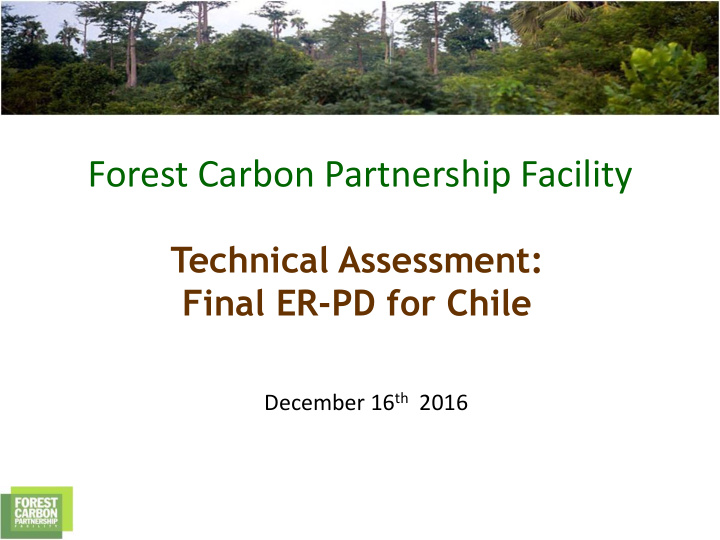



Forest Carbon Partnership Facility Technical Assessment: Final ER-PD for Chile December 16 th 2016
Presentation of TAP The technical assessment was conducted from May to November by the following team: de Jong, Ben – Mexico (Team Lead and Carbon accounting) Inthamoussu, Agustin - Uruguay (Carbon accounting) Kandzior, Angelika - Chile (Safeguards) Lopes, Ludovino - Brasil (Legal) Santibanez, Fernando, Chile (Country Expert) 2
Overall assessment of final ER-PD 1 st 2 nd Indicators not Assessment assessment met II. Level of Ambition YES 3 3 NO 0 0 N.A. 0 0 III. Carbon Accounting YES 24 29 NO 9 4 6.1; 7.1; 7.2; 8.1 N.A. 10 10 IV. Safeguards YES 4 6 NO 2 0 N.A. 1 1 V. Sustainable Program YES 12 12 Design and Implementation NO 0 0 N.A. 2 2 VI. ER Program Transactions YES 7 8 NO 3 1 36.1 N.A. 1 2 3
Summary Comments • Chile has prepared an interesting ER-PD document that can lead to an important REDD+ program. • Chile has done a very good job of putting together an impressive amount of information, both in the ER-PD and in the various annexes provided to the TAP, particularly in relation to the analysis of drivers. • The quality of the information is very good. 4
III. Carbon Accounting Ind 6.1 T he methodological steps are made publicly available Ind 7.1 All assumptions and sources of uncertainty associated with activity data, emission factors and calculation methods that contribute to the uncertainty of the estimates of emissions and removals are identified. NO Ind 7.2 The sources of uncertainty identified in Indicator 7.1: are assessed for their relative contribution to the overall uncertainty of the emissions and removals. Ind 8.1 Systematic errors are minimized through the implementation of a consistent and comprehensive set of standard operating procedures 6.1: The estimations of the areas that are degrading or enhancing in stock are based on stock charts with thresholds that determine the change, which are not available for all but one forest type. It is not clear how the areas of those forest types, for which no stock chart is available, are considered degrading or enhancing. 5
III. Carbon Accounting (2) 7.1: Estimations of uncertainties of not having stock charts are lacking 7.2: Uncertainties related to the use of regional emissions factors instead of forest emission factors are not included 8.1: No SOPs are available to describe how forest degradation and stock enhancement analysis will be carried out in future monitoring of forests for which no stock charts are available. 6
IV. Safeguards Ind 24.2 Safeguard Plans address social and environmental issues and include related risk mitigation measures identified during the national readiness process YES Ind 26.2 The description of FGRM procedures, included in the Benefit-Sharing Plan and/or relevant Safeguards Plans, specifies the process to be followed to receive, screen, address, monitor, and report feedback on, grievances or concerns submitted by affected stakeholders. • The TAP has a few recommendations that may improve the ER-PD: • The relationship between the existing FGRM mechanisms and those concerning ER-PD may be better explained in the document. • Although the ER-PD reflects a thorough concern about risk mitigation measures, certain aspects with regard to indigenous peoples could be strengthened, such as the official identification of proper indigenous representative institutions and to potential claims that may arise (or deepen) as a consequence of the interest in joining the program. 7
VI. ER Program Transactions Ind 36.1 The ER Program Entity demonstrates its authority to enter into an ERPA with the Carbon Fund prior to the start of ERPA negotiations, either NO through: • The ER Program Entity, identified as CONAF, doesn’t demonstrate to have a legal or regulatory framework, stipulating the authority to enter into an ERPA and also the ability to directly transfer Titles of ERs to the Carbon Fund that are generated on public lands. • The TAP suggest to provide a letter or any relevant document from the corresponding authority, which confirms CONAF´s ability to transfer ER titles generated on public lands. 8
Concluding remarks • All indicators of ambition, safeguards and sustainable program design and implementation are met or not applicable at this stage. • Indicators of the carbon accounting that are not met refer to the lack of stock charts for most of the forest types and the use of regional emission factors, instead of forest emission factors. Both may create accuracy-type uncertainties. • The ability of CONAF to transfer the ER title from public lands still needs to be demonstrated. • All other observations of the TAP and the CFP on the earlier draft of the ER-PD have been taken into account in the latest version. 9
Thank You! Ludovino Angelika Agustin Fernando 10
Recommend
More recommend